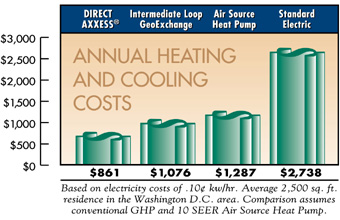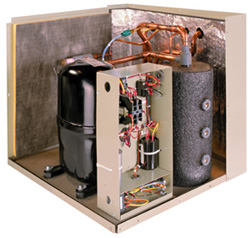Direct Geoexchange Comfort Systems: Technology Increases Performance and Reduces Costs
Copper Applications in Health & Environment
GeoExchange systems have been delivering renewable energy from the earth to heat buildings in the United States since 1945. Today, in addition to transferring heat into buildings, they heat water and work in reverse cycle to cool and dehumidify air. They also deliver greater comfort at much lower operating costs. Technology advancements since 1980 greatly simplify GeoExchange units and thereby reduce installation and operating costs, while increasing performance.
DEFINITION. GeoExchangeSM is the system also referred to as ground source or geothermal heating and cooling.1 It is an electrically powered system that transfers the natural heat of the earth to heat your home or office, and it operates in reverse to cool and dehumidify your space in summer. An optional heat reclaim device can provide virtually free water heating in summer, and proprietary technology now permits year-round integrated water heating from the same appliance. "Direct GeoExchange" is the newer technology discussed later in this Article.
COMFORT. Heat from the sun is stored in the upper surface of the earth. The amount of that heat released into the surrounding air is determined by the local median air temperature. At the northern U.S. boundary, the ground temperature below 5 feet in depth is approximately 42oF, and at the southern extreme, is about 75oF. Because the ground temperature is almost constant throughout the seasons, it provides a far higher temperature source in the winter and a cooler source in summer than does the constantly changing ambient air. GeoExchange systems utilize this advantage to deliver more uniform comfort and savings than are possible with a "high efficiency" air source heat pump. They maintain system capacity and efficiency even when outside air temperatures reach their extremes. Air source heat pumps, however, lose capacity and efficiency when the most heat is needed because the outside air is then coldest. And when cooling is most needed they again are less efficient because the air is hottest. Surveys of GeoExchange system owners consistently show that owners rank their systems higher in comfort than do the owners of any other technology, and more than 95% of those surveyed stated they would recommend such systems to friends and family members.2
IMPROVED INDOOR AIR QUALITY. GeoExchange systems improve the quality of indoor air by eliminating the combustion of fuel and its byproducts, including carbon monoxide and odors. Greater filtration is the result of longer run cycles as compared to other space heating methods, and the system maintains more comfortable humidity levels because of the absence of a furnace.
SAFETY. Without the need for combustion of fuels, there is no flame, no furnace, no fumes, no harmful emissions, and no explosive hazard. A comforting peace of mind comes with confidence in safety.
TROUBLE-FREE RELIABILITY. Without dependence upon outside air for their heat source, GeoExchange systems do not need to expose equipment to the weather, debris, pests or vandals. Elimination of the outside fan, coil, motor, and the thermal extremes experienced by the air source heat pump results in longer equipment life and less maintenance. Eliminating dependence upon fossil fuel firing to create heat in the conditioned space, the GeoExchange system is not subjected to the thermal stresses of a furnace, requires no fuel storage, and only the air filters require cleaning.
SAVINGS TO YOU AND THE ENVIRONMENT. By transferring renewable energy, GeoExchange systems reduce heating and cooling costs an average of 30-60% and reduce the cost of water heating by 70% as compared to electric resistance water heating. GeoExchangers are the most energy efficient means of heating and cooling buildings in most areas of the United States, and they are the most environmentally clean conditioning system, according to the U.S. Environmental Protection Agency and the Department of Energy. They reduce energy consumption by as much as 44% compared to air source heat pumps and by as much as 72% compared with electric resistance and standard air conditioning.3 Utility tests have shown that the greatest savings are provided by the Direct GeoExchange systems discussed later in this article.
MARKET BARRIERS. Although GeoExchangers have doubled in sales in recent years, they have not been prevalent in the marketplace. The major limitation on their success has been the high cost of installing the intermediate heat transfer loop. High cost limits market success, which, in turn, limits public awareness. A cost breakthrough has been needed to bring GeoExchange within the budget of the general population.
TECHNOLOGY ADVANCES CREATE DIRECT GEOEXCHANGE. Innovation is the result of building upon previous knowledge. To develop the next generation of simpler technology with a lower installed cost and increased performance, intensive research began in 1980 on Direct GeoExchange, which was the method initiated in that first system installed in 1945.4 Mechanical simplicity is the objective of good engineering design. The goal was to eliminate the intermediate ground loop. The first step was to create optimized refrigerant flow controls to make it possible to extend the evaporator and condenser of the refrigerant circuit into direct contact with its heat source in the earth. This eliminates the need for the intermediate plastic loop, heat exchanger and circulating pump. In 1983, this was accomplished. Work proceeded with testing multiple loop sizes and configurations for lower cost and ease of installation.
Aggressive research and field demonstrations have made these technology advances possible. Research on metallurgy, coatings, and environmental issues was conducted at the University of South Florida, resulting in system approvals by the Florida Department of Environmental Protection. Proprietary Direct GeoExchange systems were subsequently safety-certified by national testing laboratories. Monitoring has been conducted in 12-month projects from 1986 to the present by six electric utilities, the University of Central Florida, and the University of Tennessee. Coated earth loops are appropriate where sulfur or highly acidic soils may attack the copper loops. Coated loops were successfully demonstrated and tested with funding by the National Rural Electric Cooperative Association beginning in 1996.

Direct GeoExchange is the newer technology for today and tomorrow. Dramatic progress has been made to provide the simplest available means of accessing the energy stored in the earth. By taking the refrigerant circuit into direct contact with the energy source, Direct exchange eliminates the inefficiency of an intermediate heat exchanger, an auxiliary circulating pump for antifreeze fluid, and the power to operate the pump.
ECR Technologies, Inc. began the development of DIRECT AXXESS®, the modern direct GeoExchange system, in 1980, and has pioneered more innovations for GeoExchange systems than any other company. Eight U.S. patents and ten international patents have been granted to ECR. Its utility-sponsored demonstration projects are more numerous, diverse, and show higher efficiencies than any others.
Field tests of DIRECT AXXESS® systems by electric utilities in hot and cold climates began in 1986. A Michigan utility that had tested 20 systems reported that the DIRECT AXXESS® unit was 25% more efficient than systems relaying upon the plastic intermediate loop.5 A one-year test in Florida led to a Governor's Energy award for Direct exchange technology in 1988. The system also operated the most energy efficient water heater tested by the Florida Solar Energy Center (75% savings compared to electric), including comparison with solar water heaters that used electric resistance back-up heating.6
 Because DIRECT AXXESS® systems place copper tubes in the ground in small bore holes (2" compared to 6" diameter), they disturb less than 15% of the volume of earth and are easier to install as compared to systems that use an intermediate loop to circulate an antifreeze fluid. Without an intermediate loop the installer does not need plastic fusing tools, pumps to add antifreeze or training to assemble the loop. ECR loops are factory assembled. Because the heat transfer is more efficient, the Direct method uses shorter and smaller loops, and the appliance is smaller because no auxiliary heat exchanger or circulating pump is required. Therefore, costs of both installation and operation are reduced. The options of vertical, diagonal or horizontal loops of the Direct method make it possible to install retrofit units in existing homes and in the smaller lots of some newer homes. Shallow horizontal loops are often the economic choice where available land area is greater.
Because DIRECT AXXESS® systems place copper tubes in the ground in small bore holes (2" compared to 6" diameter), they disturb less than 15% of the volume of earth and are easier to install as compared to systems that use an intermediate loop to circulate an antifreeze fluid. Without an intermediate loop the installer does not need plastic fusing tools, pumps to add antifreeze or training to assemble the loop. ECR loops are factory assembled. Because the heat transfer is more efficient, the Direct method uses shorter and smaller loops, and the appliance is smaller because no auxiliary heat exchanger or circulating pump is required. Therefore, costs of both installation and operation are reduced. The options of vertical, diagonal or horizontal loops of the Direct method make it possible to install retrofit units in existing homes and in the smaller lots of some newer homes. Shallow horizontal loops are often the economic choice where available land area is greater.
The cost of loop installation is substantially less with a Direct system. A 4-ton vertical Direct GeoExchange loop, for example, can be installed for approximately $1,000 less than a vertical intermediate loop system. Even greater savings are realized with a horizontal pit installation for a Direct system. Simplifying GeoExchange with the Direct exchange method reduces costs, while also increasing the performance of GeoExchange systems in the same manner as the phenomenon experienced with the progression of hand-held calculator technology in the 1980's.
The simple, state-of-the-art DIRECT AXXESS® system has the ability to consistently move three to four BTU's from the earth for each BTU equivalent of energy used to operate the system and to deliver all of those BTU's into the building. This is an efficiency of 300-400%. The Direct GeoExchange system delivers improved performance to people concerned with energy costs, the environment, quality of life, and natural resources. It is the natural choice space conditioning system for living and working environments for the twenty-first century.
Copyright 1998, ECR Technologies, Inc., Lakeland, FL
Ph. 863 701-0096
Fax 863 701-7796
www.ecrtech.com
Contact:
Andrew G. Kireta Jr.
National Program Manager
P.O. Box 940
Franklin, IN 46131
Tel: 317-346-6442
Email
References:
By Hal Roberts ECR TechnologiesAlso in this Issue:
- Direct Geoexchange Comfort Systems: Technology Increases Performance and Reduces Costs
- Copper DX Geothermal Heat Pump Web Site
- The Secret to Staying Young
- The Evolution of Telephone Cable
